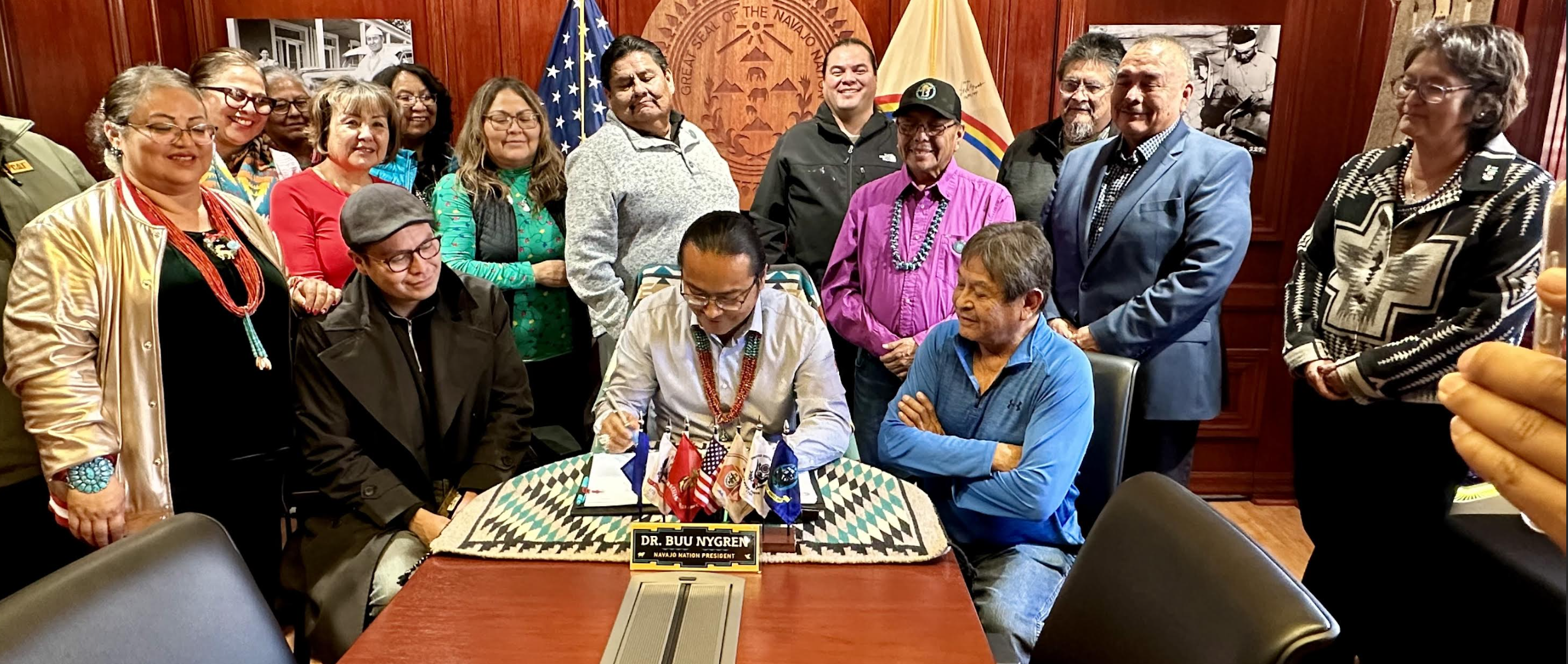
- Details
- By Native News Online Staff
On Christmas Eve, Navajo Nation President Buu Nygren signed long-awaited legislation to have the Navajo language used, taught and supported by appropriations. With his signature, Diné bizaad, is now the official language of the Navajo Nation.
“One of my priorities coming in as President has always been to make sure that we make Navajo cool again,” he said. “It's exciting to see the work that's being done. And, so, I commend the Navajo Nation Council for doing that, and I really want to commend all of you for doing that.”
 Make A Donation Here
Make A Donation Here
Navajo Nation Council Delegate Shawna Claw sponsored the legislation to establish Navajo as the official language of the Navajo Nation.t states, “Since time immemorial, our people have survived by maintaining our value system given by the HoIy People. The core of our value system is embedded in the language.”
“As Diné, we are the image of our ancestors, and we are created in connection with all creation. Upon our creation we are identified by: Our Diné name, our clan, our language, our way of life way, our shadow, our footprints. Therefore, we are called the Holy Earth-Surface-People – Diyin Nohookáád Diné."
President Nygren emphasized that today's leaders must ensure future generations of Navajos have the opportunity to learn the language of their grandparents and great-grandparents.
“What kind of opportunities can they have to learn our beautiful Navajo language?” he asked. “Today is going to be a good day because we're going to sign that into law. Then it's the official language of the Navajo Nation.”
He said he is grateful to all the teachers of the Navajo language who work hard across the Navajo Nation to teach this precious language to young ones.
“Signing this into law is really going to showcase to them that they're the ones that should be put at the forefront when they're really making things work,” he said. “Again, all the Navajo language teachers out there, thank you.”
He expressed his desire to establish a program that trains lawyers and judges to speak Navajo, enabling them to serve on the bench. Additionally, he aims to collaborate with the Diné Language Teachers Association to promote the use of the Navajo language.
He shared that he reflects daily on ways the Nation can make significant strides in fostering the use, preservation, and perpetuation of the Navajo language. He also noted that his office includes a veterans liaison, an MMIW representative, and a disabilities liaison to provide support when needed.
“Then I thought to myself, why can't I have a Navajo language and cultural advisor?” he asked.
After a Google search, he discovered longtime Navajo language teacher and translator Peter Thomas had worked on children’s books like the ones he reads daily to his children.
He called Salina Bookshelf in Flagstaff that specializes in a wide variety of Navajo language books to inquire about Mr. Thomas.
“I said, hey, do you have Peter Thomas' number? I'd like to give him a call,” the President said.
In November, Mr. Thomas was hired as an Executive Staff Assistant to implement strategies and approaches to make Diné bizaad “the heart of my administration.”
“When you come to the Office of the President, you will see signage about Keshmish in Diné bizaad,” President Nygren wrote to the Council. “These phrases are learned or reinforced in our office and taken home by the staff to share with their families this holiday season.”
The President said one of the first executive branch projects will be to have the Navajo Division of Transportation design stop signs in the Navajo language that read "Ałtsé."
Next, the Division of Public Safety will have Navajo Police cars display the word for police, "Silao."
“All across the Navajo Nation, I want to say thank you to the Navajo Nation Council for championing this legislation, and to the sponsors and everybody that's been involved and that voted to really make this happen,” the President said.
“I think that to really fulfill the intentions of the legislation, how do we put some dollars and resources behind it so that we can actually put a dent into teaching the language,” he said. “I think in order to do that, we're going to need some dollars and resources actually allocated with this legislation.”
Create your own user feedback survey
More Stories Like This
50 Years of Self-Determination: How a Landmark Act Empowered Tribal Sovereignty and Transformed Federal-Tribal RelationsNavajo Nation Council Members Attend 2025 Diné Action Plan Winter Gathering
Ute Tribe Files Federal Lawsuit Challenging Colorado Parks legislation
NCAI Resolution Condemns “Alligator Alcatraz”
NABS Documents 134 More Survivor Stories, Expands Digital Archive in 2025
Help us defend tribal sovereignty.
At Native News Online, our mission is rooted in telling the stories that strengthen sovereignty and uplift Indigenous voices — not just at year’s end, but every single day.
Because of your generosity last year, we were able to keep our reporters on the ground in tribal communities, at national gatherings and in the halls of Congress — covering the issues that matter most to Indian Country: sovereignty, culture, education, health and economic opportunity.
That support sustained us through a tough year in 2025. Now, as we look to the year ahead, we need your help right now to ensure warrior journalism remains strong — reporting that defends tribal sovereignty, amplifies Native truth, and holds power accountable.
 The stakes couldn't be higher. Your support keeps Native voices heard, Native stories told and Native sovereignty defended.
The stakes couldn't be higher. Your support keeps Native voices heard, Native stories told and Native sovereignty defended.
Stand with Warrior Journalism today.
Levi Rickert (Potawatomi), Editor & Publisher

